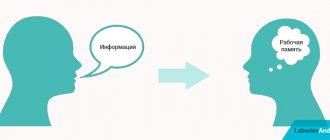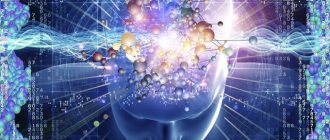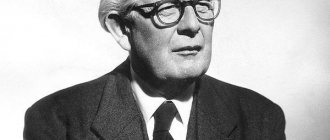Look at an object near you and then close your eyes. For a short time (about 0.5–1 second) you will continue to “see” him with your eyes closed. In the same way, but for about 2 seconds, brightly and without changes, a copy of what was heard is stored in memory - like an echo. These examples demonstrate the manifestation of a sensory type of memory - ultra-short-term imprinting of objects by our senses. In general, extreme transience and perception at the sensory level are the main characteristics of sensory memory.
The sensory systems of the human body are inertial; they prolong the effect of incoming signals for a short time. This is expressed in the fact that after exposure to a stimulus signal we continue to feel it for some time. This inertia, in essence, represents instantaneous (sensory) memory - the simplest process at the receptor level. While reflecting information received by the senses, sensory memory does not process it.
In psychology, sensory memory is also called immediate, since it is a direct impression, an imprint of information received through a system of sensors - organs that contribute to the perception of the surrounding world (hearing, vision, touch, etc.).
Place of sensory memory in the information processing system
Human memory is an amazing active system that performs many important functions: it receives information, takes care of its systematization, preservation, transformation, and reproduction. Similar to a computer: at the initial stage, information is converted into a form suitable for processing, then held in the system, stored, and, if necessary, retrieved from storage and reproduced.
In order for us to remember information for a long time, it has to go through at least three phases: processing in sensory, short-term and long-term memory. During the short period of time while the information is stored in sensory memory, the question of whether it is necessary to involve higher parts of the brain in processing the received signals is decided. If yes, the information enters short-term memory for further processing. If not, the information is erased and replaced by new information, that is, sensory memory is filled with other, new signals. In long-term memory, the main encoding process takes place, based on the results of analysis and recognition of various characteristics of information.
Between sensory and short-term memory, there is another type of memory, the so-called operative memory, which helps to retain some intermediate results in the mind when performing complex operations.
World of Psychology
to the Table of Contents
Section 1 Experimental psychology of memory
Memory models
Models of short-term memory
Closely connected with perception, being, as it were, its inertia, short-term memory was considered as one of those lower basic processes that are the basis of more complex functional formations. However, as studies carried out over the past 25-30 years have shown, quite complex transformations of input information can also be carried out in short-term memory.
A number of models of short-term memory have been proposed. D. Broadbent (1958) put forward the principle of hierarchy in the organization of memory and postulated the existence of two submechanisms involved in information processing: the P-system and the S-system, interconnected. The S-system is short-term memory, the P-system carries out the processes of information processing and long-term storage (Fig. 1). The P-system has all the characteristics of a limited-bandwidth channel that transmits events in a sequential manner. It functions effectively as long as it is not overloaded. If events follow each other in quick succession, they are stored in the S-system. Thus, in accordance with D. Broadbent’s model, when the P-system operates in a limited mode, temporary storage of information is carried out by the S-system, which is characterized by rapid loss of information.
According to D. Broadbent, the short-term storage system has the character of a buffer storage device. A similar buffer model of short-term memory is proposed by R. Atkinson (1966). According to Atkinson, the short-term memory system is a “buffer” that holds a fixed number of units, the number of which depends on the nature of these units (Fig. 2). Unlike D. Broadbent's model, where short-term memory is characterized by simultaneous reception of information, R. Atkinson assumes a successive order of filling the buffer.
Fig.1. D. Broadbent's model of short-term memory.
Fig.2. R. Atkinson's model of short-term memory.
Fig.3. J. Sperling's model of short-term memory.
Its sequential filling with elements is carried out in such a way that each subsequent element knocks the previous one down one cell. This process continues until all buffer cells are filled. The units arriving after this knock out the “oldest” ones, and they are lost. Atkinson's model of short-term memory is the result of transferring to human memory the principles of constructing machine memory used in computers.
A significant step in determining the real mental functions involved in the general process of information processing is the research of J. Sperling (1967), summarized in his model of short-term memory. The specificity of this model lies in the structural approach to the problem of short-term memorization. The elements of the model are visual memory, scanning block, repetition block and auditory memory (Fig. 3).
Visual memory is a period of information processing that precedes the period of short-term memorization and is distinguished by a greater volume of memorization than is typical for short-term memory. The content of visual memory is quickly erased, its duration varies from a fraction of a second to several seconds depending on the intensity of the stimulus, the contrast with the background, the duration of stimulation, and the nature of the pre- and post-exposure fields. The main amount of information is erased from visual memory within 250 ms. After this time interval, the volume of visual memory is equal to the volume of short-term memory. This allowed J. Sperling to hypothetically equate visual memory with the inertia of sensation and present it in the form of an inertial, quickly fading trace of the stimulus. Sperling notes that longer-term visual memory (with a storage time of 1000 ms or more) can appear in the form of afterimages that move along with eye movements. The function of visual memory is to store an image between two eye jumps. Visual memory is two-dimensional: its content can be scanned horizontally and vertically. From visual memory, information is sequentially transferred to other blocks of the model.
The sequential transfer of information from visual memory is ensured by the scanning process. Scanning of the contents of visual memory occurs at a speed equal to 10 ms per character, regardless of the number of letters in the stimulus series. There is a certain latent period for turning on the scanning unit, the value of which is estimated at 30-50 ms. To determine the scanning speed in Sperling's experiments, a line containing 6-7 letters was used as a test stimulus. The time of presentation of the test stimulus varied from 5 to 65 ms in steps of 10 ms. Immediately after turning off the test stimulus, a masking stimulus was presented for 120 ms. The results obtained showed that the first 3-4 letters are scanned at a speed of 100 letters per second, the scanning speed of subsequent letters decreases greatly.
The units scanned in visual memory are the input for another element of Sperling's model—repetition. The output is internal and external speech reactions. The repetition rate is less than 10 syllables per second, usually 3 syllables per second.
With the subsequent development of his model, Sperling introduces another functional block between the scanning and repetition blocks - the “recognition buffer memory”. The functions of this block are to highlight informative features, categorize the information received in it, and select significant information. The speed of information processing in the recognition buffer, according to Sperling, is 10-15 ms per symbol. This time most likely coincides with the operating time of the scanning unit.
Speech response units are the input to auditory memory and are held there for a few seconds, during which time they are usually repeated again. The speech response allows for feedback as speech sounds are returned to auditory memory. The possibility of generating feedback from auditory memory explains, in the opinion. J. Sperling, the important role played by inner speech and auditory memory in short-term memory.
J. Sperling's experiments, which allowed the author to develop a model of short-term memory, were carried out using the method of partial reproduction of a tachistoscopically presented set of stimuli. His subjects correctly reproduced the part of the test set given to them in the post-stimulus instruction, which indicated that by the time the instructions were given they still remembered the entire set of stimuli. The delay time of the post-stimulus instruction thus coincided with the time of information storage in the visual system. The works of J. Sperling laid the foundation for a number of studies of visual memory carried out by various authors. The results he obtained have been repeatedly confirmed in other studies. Moreover, the time of information storage in the visual system was different in different experimental situations and ranged from 300 to 1000 ms.
The ability of the visual system to store all presented information is associated with the phenomenon of visual aftereffect, known since the time of G. Helmholtz. An unlimited amount of information is recorded and stored in traces, and the recording is literal. Therefore, this type of memory, which essentially represents the input state of the visual system, was called by W. Neisser iconic (from the word icona - image) memory. This type of memory is also called perceptual memory, sensory register, primary memory, etc. Iconic memory has also been found in the sense of touch.
A number of experimental studies have proven the existence of auditory perceptual, or echoic, memory. Thus, in the experiments of D. Norman (1969), a series consisting of six numbers was presented to the subject’s left ear for memorization. At the same time, monosyllable words were presented to his right ear, each of which he had to repeat immediately after its presentation. The last condition did not allow the subject to verbalize the auditory image of the stimuli presented for memorization. Thus, his response should have reflected only that part of the information that was stored in the form of an auditory image. testing was carried out using the identification method either immediately after the presentation of a series of numbers, or after 20 seconds. The results showed that during immediate testing, the subject is able to correctly identify at least 30% of the presented numbers, and during delayed testing, the number of correctly identified numbers is close to zero. This means that a small part of the presented information was retained in the auditory perceptual memory until the time of testing. The storage time of information in echoic memory varies from 25 ms to 3 s.
D. Norman distinguishes three types of memory: storage of perceptual information, primary and secondary memory. In addition, the author believes that in order to effectively introduce new material into memory and coordinate it with old material, it is necessary to have a “buffer” memory that would store sensory material until it is correctly interpreted.
Thus, iconic memory performs a number of important functions.
- Firstly, it is the storage of information, which provides the entire space of stimuli for the subsequent selection of relevant information, carried out using other functional blocks.
- Secondly, the presence of iconic memory, which acts as a means of communication between present and past traces, is an important condition for the continuity of the visual system. Echoic memory allows us to understand speech.
- Thirdly, iconic memory serves to control the adequacy of those transformations that are carried out at other higher levels of the hierarchy of transformations of input information.
Finally, under conditions of short-term presentation of a stimulus, iconic memory acts as its substitute.
Some authors have questioned the ecological validity of the concept of iconic memory. Thus, R. Haber argues that the concept of an icon is hardly useful for ordinary visual information processing tasks, with the exception of reading during a thunderstorm. The argument against iconic memory, from Haber's point of view, is the fact that in human perception there are usually no short-term fixations and our head and eyes are rarely stationary. Proponents of iconic memory argue that the existence of icons cannot be denied. They are created during the first tens of milliseconds of fixation, after which it is no longer the stimulus that is perceived, but the iconic image.
Tactile memory.
In the previous article, we discussed the need to develop visual memory in connection with the ability to concentrate and remember large amounts of information. However, for a fully developed memory, its different types must complement each other, and tactile sensations and actions for which tactile memory is responsible become good support for visual images.
The development of tactile memory can be more difficult than visual memory, because this type of memory is rarely used in everyday life. Therefore, training should be started only with the proper level of development of visual memory, and you also need to pay attention to the gradual work with tactile images and increasing sensitivity. At the highest level of development of tactile imagination, you will be able to feel the image on your skin and change it even with your eyes open.
You should start, as with the development of visual imagination, by memorizing various images, modeling them on the skin: the touch of a pen, brush, sharp pencil, light blows. Repeating them, changing the place of touch, remember your sensations and gradually try to restore them without a material stimulus. The same results can be achieved with another technique that is good for developing children's memory: you can “write” letters or numbers on the skin. Trying to recognize them, the child will not only develop tactile perception, but will also remember the sensations from touch and will be able to subsequently recreate them in memory.
Tactile and visual imagination are closely related: understanding the sensations of a visual image helps to better retain it in memory and more easily restore the information associated with it when using the “Memory Palace”. In addition, visual information can be directly related to sensory material. To do this, when memorizing something, you need to touch a certain material: wood, cotton wool, metal, even a pen or pencil. With regular training, recalling information will evoke a figurative sense of the material, and vice versa, which can be a good help in preparing for exams and tests and in addition to other methods of memorizing large amounts of information. By the way, this applies not only to touch, but also to taste and olfactory sensations: it is not for nothing that students are recommended before the exam to chew the same gum as the one they chewed during preparation. But we will talk about these rarely used types of memory in the next article.
Main Factors
Sometimes it’s impossible to remember what you need, a person thinks about something else and cannot concentrate on the work of the brain. Psychologists identify several elements that influence the speed and quality of memorization. Sensory memory is a close relationship between the senses and operating factors:
- Mechanical and conscious memorization. The first option provides less benefit than the second. It is necessary to think about what needs to be remembered, to focus on details.
- Comparison. The process helps you focus on a specific image and highlight features.
- Systematization. When information relates to structure or type, it is much easier to master the volume through the desired category.
Memory training, using various techniques and focusing on details will help over time not only increase the ability to memorize, but also improve the quality of reproduction.
Types of human memory
Types of human memory are determined by analyzers that transmit information about the surrounding reality.
Kinds:
- visual
- auditory
- gustatory
- olfactory
- sensory (tactile)
People have all types of memory. Already a newborn has some. Thanks to olfactory memory, the mother is distinguished from other people.
The presence of taste memory can be observed by replacing the usual feeding with a different mixture (the baby will be suspicious of the new taste).
Visual memory is considered the most developed. It is thanks to it that images of objects in the surrounding world are stored and reproduced, and people are recognized.
Auditory memory stores information coming from the hearing organs (music, speech).
Olfactory memory – storage of various odors. It is formed throughout life, in some it reaches a high level of development.
Tactile (sensory) memory - remembering the sensations that arise when touching a specific object. Usually it complements the visual image, enriching it with the temperature and texture of the object.
Taste memory is based on remembering the taste of various foods. Anyone will remember the taste of familiar dishes or products once tried.
Some people have a dominant memory type than others.
Artists have developed visual memory and are able to recreate an accurate portrait or painting without having the original in front of their eyes.
Musicians with a high level of auditory memory are able to repeat a piece of music heard once in detail, accurately reproducing the notes.
The level of development of various types of memory should be taken into account in training. They can be developed with special exercises.
You can get additional information about types of memory from the proposed video.
Touch type
A type of memorization that is based on the influence of stimuli on the senses. Can be long-term if the irritants are strong. The process is not perceived separately from other types, because it combines the complex work of not only the cerebral cortex, but also the nervous system and the body as a whole.
A feature of the species is the ability to retain memories after the stimulation has stopped. Sensory memory is a complex process that facilitates the rapid acquisition of facts.
Between this and the short-term type of the described process there is an intermediate element - RAM. It allows you to perform an action or procedure on a mechanical level, without thinking about the details of execution. This sensory type of memory is associated with physical processes. As the work progresses, some elements may be forgotten. If information affects the cerebral cortex, then parts of operational memory become short-term.
There are several levels in the structure of the sensory view:
- Direct. This includes sensory memory, which consists of two additional elements.
- Short term.
- Long-term.
Regardless of what type of memory predominates in terms of perception and processing of information, it can be trained and the stock of facts can be increased. And drawing up the correct classification of the material allows you to quickly find what you need.
Body memory
Studying different areas of psychology, I never cease to be amazed at the possibilities of different psychological methods, I was especially struck by the possibilities of Body-oriented psychotherapy in working with clients: it is very effective with both children and adults. What struck me? I was amazed that by influencing the body, images come into a person’s consciousness, often associated with even very early childhood, often these are memories that have been repressed and are no longer conscious; also, influencing the body, there is an awareness of problems, the release of suppressed and deeply hidden in the body of emotions and feelings. Freeing the body from clamps and releasing emotions frozen in the body leads to changes in the psyche. Changes occur both in the understanding of the situation and in the attitude towards it, reactions and behavior also change.
We come into this world whole, but as we are raised and socialized, parents and the environment have a huge influence on the formation of the child’s personality, on his character, on his behavior, on his way of interacting with other people, on his attitude towards himself. Four basic problems appear - overcontrol, contacts, support and self-confidence, self-identity. We acquire them when we lose contact with ourselves. And thus the past accompanies a person until the moment a person decides to change and improve his life.
For example, many people have a fear of expressing their opinion, expressing themselves, telling their boss or spouse that they are not satisfied, instead it feels like a lump in the throat or resentment and avoiding solving problems. It’s just not easy to say or do what you want while you have the pressures you acquired in childhood. Mom closed her mouth, once slapped her on the lips, did not listen, but said, for example: “It’s too little for me to tell you,” - so in adulthood, our learned model of behavior is repeated. And no matter how much we understand that we can do otherwise, only a block prevents us from being ourselves.
As children, we learned certain patterns of behavior, often by suppressing our desires and internal impulses; here, every adult has his own story. And in early childhood, we learned certain ways to avoid pain, despair and fear, as well as ways to receive the love of others. This is how we adapted to the reality in which we found ourselves, and the development of our individuality, and with this “baggage” received in childhood, we live in this world... Every experience that a person has experienced remains in the human psyche and body. The body remembers everything from the moment of birth: emotions, situations, memories, so through the body you can work with any human experience. This is resentment, unexpressed anger, unexpressed tears, suppressed feelings - everything lives in us and our body. We live until we ourselves want to free ourselves from unnecessary, unnecessary and ineffective behavior, beliefs, and feelings. As we grow up, we become stronger and more mature. However, some of us need therapy to clarify our deepest feelings. One of the advantages of us adults is that we are no longer helpless children and can take apart and change what we have for what we need and want, then we can become what we ourselves want. With chronic muscle tension, which is accompanied by loss of grace, feelings of coldness, discomfort in the body, redness of certain areas of the body, there are muscle tensions, and it is necessary to fight at the body level.
Our bodies reflect our experiences
Every experience that a person goes through touches his body and remains in the psyche. If the experience is pleasant, then it has a positive effect on the health, vitality and grace of the body. In the case of painful negative experiences, the opposite is true. If a person can adequately respond to the insult inflicted on her, then its consequences will not be long-lasting, since the wounds heal. But if the reaction is blocked, the insult will leave a mark on the body in the form of chronic muscle tension. This reaction does not die, but only retreats inside the body and continues to exist in the subconscious. It can be reactivated during therapy or after some strong experience. Until this happens, the muscle group involved (in this case, the muscles of the lips, cheeks, throat) will remain in chronic tension. Reason and awareness will not help when we are dealing with suppressed feelings because they are unconscious. Suppressed feelings remain in us and continue to influence us, preventing us from being more free, open with people, building relationships, achieving our goals, trusting ourselves, others and the world.
As we grow up, we become stronger and more mature. However, some of us need therapy to clarify our deepest feelings that continue to influence us, our behavior, and our relationships with others.
Often, awareness of the reasons influencing the difficulty that has arisen, the ability to look at the situation differently, understanding what can be changed, and seeing new horizons in one’s life helps one to move through life more calmly and confidently. Quite often there is an understanding of oneself, one’s desires, strengths and weaknesses, which gives a person the opportunity to be in contact with himself and the world.
Do you ever feel tension, pain, discomfort and stiffness in your body?
You need to understand that what happens on a person’s emotional level is reflected on his body. Whether we understand it or not, whether we want it to be so or not, it really is so. These can be unspoken words, anger, aggression, suppressed feelings and desires. The tension that has arisen does not go away; it remains in our body.
One of my methods of work is Body-Oriented Therapy, which helps, through working with the body, to remove blocks and remove tension in the body. Working through muscle tension, which is the basis of psychological difficulty, allows you not only to solve the problem, but also to activate internal energy and rely on the resources of the body. This is the main difference and advantage of body therapy over other psychotherapeutic methods.
Methods of body-oriented psychotherapy help in gaining confidence, expressing oneself without constraining the body, relieving tension, stress and their consequences, working through over-control, blocks in the body that prevent one from getting pregnant, as well as releasing hidden feelings (in connection with different situations) and interfering live as you want.
The goal of body therapy is to get rid of the influence of negative experiences experienced in the past on the present and get the desired changes.
Types of memory
Psychologists identify several subtypes, each of which cannot exist separately, but is directly related to the others.
These are complex brain functions that scientists and doctors have been studying for centuries. Now in the mental system there is:
| Memory type | a brief description of |
| Sensory | Instant imprint of information and facts on the peripheral parts of the analyzers. Can be divided into iconic and echoic memory. |
| Short-term | A work process during which only a small part of the entire semantic flow is absorbed. In order for the volume to be large, it is necessary to train the sensory organs. |
| Secondary | Memory is based on personal experience and experienced emotions. Moments associated with certain sensations are remembered. It is divided into declarative and procedural processes. |
| Memory for distant events | The ability to remember certain facts and events on a subconscious level. The same emotions as at the moment of remembering will help to evoke memories in the future. The process is spontaneous and is not completely controlled by a person. It can be either short-term or long-term. |
Storing information is possible due to the use of different types of memorization. Thanks to analyzers on the temporal lobes of the cerebral cortex, processes of renewal and repetition of what has already been seen or heard occur.
A close connection with neurons allows not only to reproduce information, but also to convey an emotional background. There are several mechanisms for retrieving information from memory.
Echoic type
The basis of memorization is auditory perception of information. An effective technique, especially if there are no additional distracting elements. Unlike the visual type, there is no way to compare facts with images or emotions. Voice timbre, rhythm and strength are important for memorization. The ability to reproduce what was previously heard depends on the speed of information processing.
To enhance the memorization effect, scientists recommend accompanying the auditory type with tactile sensations so that information is connected with sensations. Data recording in this case will take place through the somatosensory system.
Long-term memory
Long-term memory allows the brain to store information for a long time. This type of memory is considered almost permanent; everything in it depends on the consolidation (unification) of what is remembered.
If the information is an object of true attention, it is stored, otherwise it is lost. Information deemed suitable for reuse is transferred from short-term memory to long-term memory. The latter serves as a repository of firmly assimilated data. It seems its volume is unlimited.
Scientists believe, and a practice report can be ordered on this topic, that in long-term memory, data that requires long-term storage is contained in encoded form. It contains various “sinks” of information: a person’s knowledge of the world around him and scientific knowledge (semantic memory), his biography (episodic memory), motor skills and content that is never forgotten (procedural memory).
In accordance with the type of storage and content of information, long-term memory is divided into several types.











